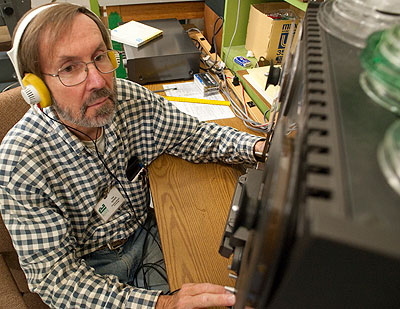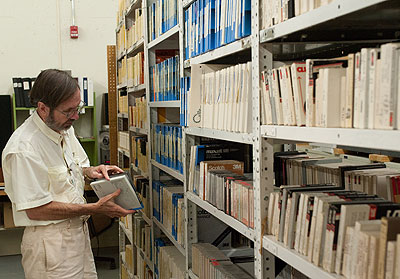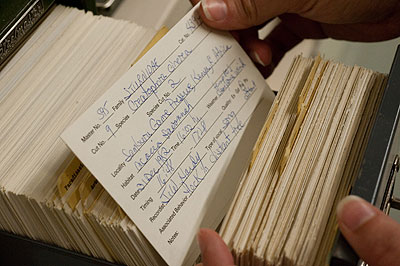
Photo by Jeff Gage
Ornithologists at the Florida Museum of Natural History are preparing to digitize nearly all of the museum’s analog bird-sound field recordings, one of the largest collections in the Western Hemisphere with 23,650 cataloged recordings representing about 3,000 species.
Funded by the National Science Foundation, the three-year, $446,000 project will make the collection more readily available to scientists and the public for bird research and identification.
The project will involve more than 2,200 reel-to-reel and cassette tapes of a diverse collection of bird sounds, with a primary focus on New World birds. The digitization process, which begins in January, will result in public access to the recordings via the museum’s Web site. The museum plans to one day have all its recordings available online. The only sounds currently available are brief recordings of 99 Florida birds.
“Virtually the entire collection will be available in some form on the museum Web site,” said Thomas Webber, ornithology collection manager at the Florida Museum. “It includes excellent field recordings dating back to the 1960s from a number of active amateurs and prominent professionals.”
The tapes, currently stored at the Florida Museum, will be shipped in batches to the Borror Laboratory of Bioacoustics at Ohio State University to be digitized.

Photo by Jeff Gage
“Some of the recordings may be irreplaceable,” said Douglas A. Nelson, director of the Borror Lab. “In many cases, the recordings may be unique and may be of species that occupy habitats under increasing threat from human exploitation.”
The Florida Museum has the Western Hemisphere’s second largest collection of bird sound recordings in terms of number of species and the third largest in terms of the actual number of recordings. Cornell University and the Borror Lab have the other top collections.
The Borror Lab is a pioneer at converting analog tape collections to digital media, and the Florida Museum has worked with researchers there for decades, Webber said.
The grant will pay for equipment and staff time to make and store the digital copies and build upon the museum’s current bird sound database.
Webber estimates the entire collection will fit on a single hard drive. Florida Museum will store the analog tapes after they’re digitized. Copies of the digital recordings will be housed at both the Borror Lab and the museum on hard drives and in CD form.
Benefits of digital
Studies have shown that analog tape degrades after 40 to 50 years. Transferring the recordings to digital format will ensure their permanence, Nelson said. Florida Museum staff will also have an easier task providing copies of the recordings to scientists, governmental agencies, other museums and bird watchers.

Photo by Jeff Gage
Currently, requests require that someone find and correctly cue the needed reel in the database and then make a digital recording of the specific bird sound, Webber said. The process is time-consuming, and repeated use eventually reduces the tape’s sound quality.
Unused analog recordings also face the risk of deterioration as the oxide coating starts to break down. Magnetized recording patterns also can bleed through to adjacent segments of the tape.
The Florida Museum plans to re-issue some of the 26 bird-sound compilations, a total of more than 1,400 sounds, originally produced by J.W. Hardy, the museum’s curator of ornithology and bioacoustics from 1973 to 1995. Those audio cassette compilations include “Sounds of New World Owls” and “Voices of the Wrens.” Webber said the recordings were extremely popular when cassettes were the standard audio format.
Webber’s priority will be to re-issue recordings of birds that are more readily heard than seen, such as owls and other nocturnal birds, a total of about 200 species. He also plans to issue one of Hardy’s most popular recordings, “Sounds of Florida’s Birds.” The recording forms the basis of the museum’s current Web page of bird sounds, www.floridamuseum.ufl.edu/birds/florida-bird-sounds/, and provides an audio snapshot for featured birds.
Vast catalogue
In addition to the 2,200 catalogued recordings, the Florida Museum has 600 to 700 reels that have yet to be catalogued. Those may be more difficult to process, Webber said. Some important contributors to the collection have been excellent at field recordings but not so good at recording the data. Consequently, some of the tapes are lacking critical information on date, location and species recorded.

Photo by Jeff Gage
“We have cataloged probably 95 percent of the recordings that are going to turn out to be scientifically useful,” Webber said.
The museum’s bird sound collection resulted largely from Hardy’s efforts, he said. Hardy was one of the first ornithologists to publish audio spectrograms of bird sounds for use in his studies on the vocalizations of jays.
Hardy also had a talent for getting amateurs and professionals alike to donate their recordings to the museum’s collection, adding to both its breadth and depth, Webber said.
With such a vast collection and limited staff, volunteers played an important role in cataloging the collection and preparing for the digitization. Local birdwatcher Cathy Reno cataloged about half the collection in the 1980’s and 1990’s, completing information sheets on each recording and preparing catalog cards for a species cross-index. Barbara Muschlitz, a museum volunteer since 1985, entered virtually the entire catalog into the computer database.
Ohio State workers will use the database to create tags for each of the recordings. “If it weren’t for the volunteers, we would not have good documentation for the collection,” Webber said.